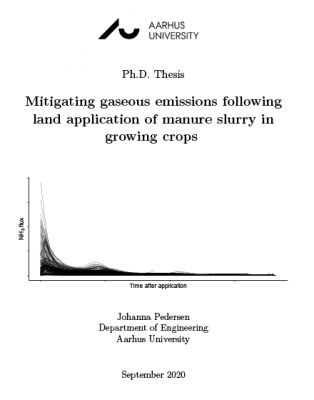Mitigating gaseous emissions following land application of manure slurry in growing crops
Synopsis
The agricultural sector contributes substantially to global pollution, as it accounts for a significant amount gaseous emission of ammonia (NH3), greenhouse gases, volatile organic ompounds (VOC), and hydrogen sulfide (H2S). Agriculture accounts for 75% of the global NH3 emission with the primary sources being production units for livestock, storage facilities and land application of animal manure. Regardless of continuously updated legislation and regulations, Denmark does not meet the targeted NH3 reduction agreed upon in the National Emission Ceilings Directive from the European Union.
Field application of liquid animal manure (slurry) accounts for 28% of the NH3 emissions in Denmark. For decades research has been carried out in order to mitigate these emissions. Several factors affect the emission, such as soil, slurry, and crop type and conditions, meteorological conditions, and application method and rate. Furthermore, all of the parameters interact with each other, making it difficult to isolate and quantify singular effects. Different strategies are applied in order to mitigate emissions, including manure reatment prior to application, optimal field management (crop rotation allowing direct soil injection), timing of application, and low emission application techniques. In growing cereal crops most low emission application techniques apply slurry at the surface in bands.
Although extensive research has been carried out, there is still a knowledge gap concerning the interaction effects. There is a need for a high precision measurement method that can quantify NH3 emission patterns and relatively small differences in cumulative emission in order to document the effects.
The research in this Ph.D. thesis examines the mechanisms that have an impact on NH3 emission from surface applied manure in growing crops in order to investigate which circumstances will lead to successful or unsuccessful abatement using both well known and new application techniques. For this purpose, a system of dynamic chambers and online measurements of NH3 flux with Cavity Ring-Down Spectroscopy was developed. A series of field experiments were conducted with this system under a large variety of conditions. The measuring system allow for NH3 flux measurements with a low variation, high time resolution, and long measuring periods. In addition, a new method for quantification of the exposed surface area (ESA) of the slurry at the soil surface over time has been developed. It is demonstrated that the method can be used to gain further knowledge about
the slurry-soil interaction after surface application of slurry.
The results presented show that the interaction between soil type and application technique is important when assessing the low emission application techniques in terms of their success in reducing emission. Measurements of ESA proved useful as an explanatory variable to explain why different slurry treatments mitigate the emission under certain circumstances but not under other. The ESA results also highlights the importance of gaining further knowledge about slurry infiltration into the soil after application and haracterization of increased dry matter in the air-slurry boundary layer including quantification of a possible crust formation.
Air temperature is known to have an important effect on NH3 emission. Analysis of data from 19 experiments reveals a positive response of cumulative NH3 emission to the emperature at application up to a temperature of approximately 14°C. After this, a further increase in temperature does not change the cumulative NH3 emissions. It is hypothesized that the absence of temperature effect over a certain point is caused by an increased resistance of NH3 transport due to increased dry matter at the slurry-air interface.
When combining a Proton Transfer Reaction Time-of-Flight Mass Spectrometer with the dynamic chambers, it is possible to measure, identify, and quantify emissions of non-methane VOC and H2S after field application of manure. The system allows for precise measurements of the emission dynamics over time and estimations of the odor activity value.

